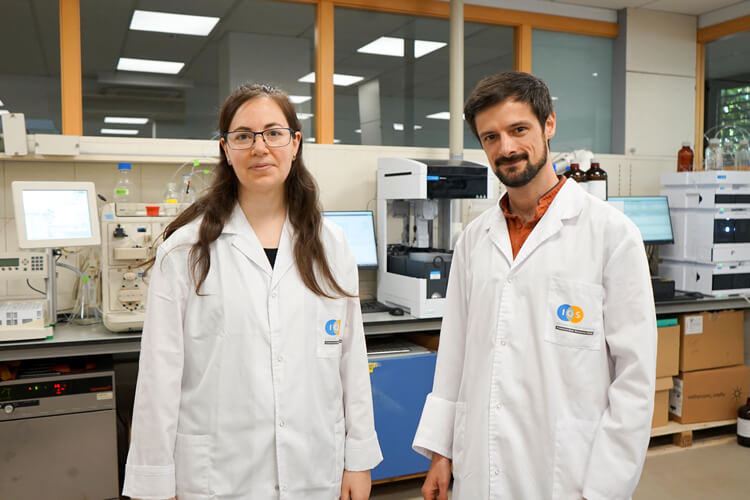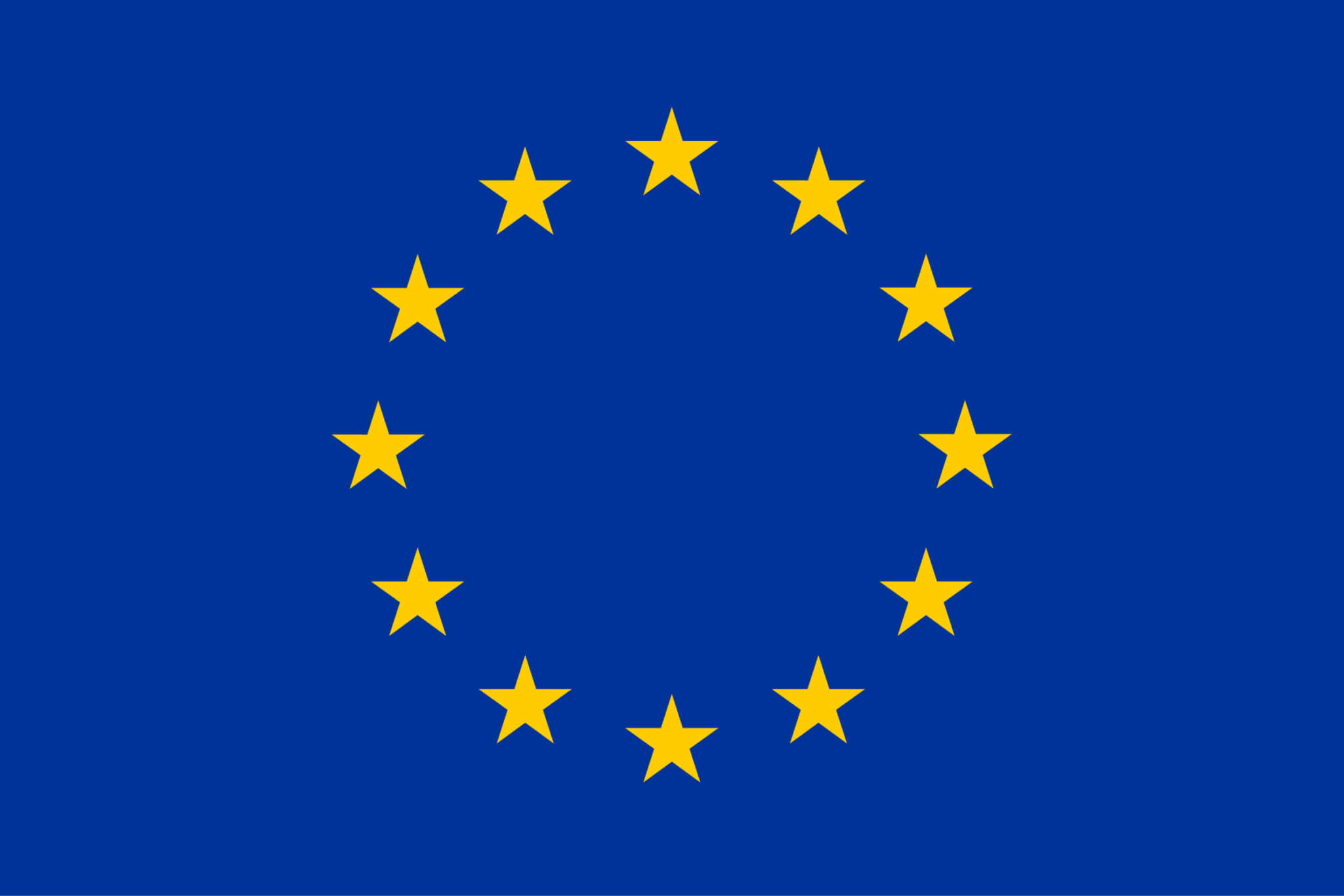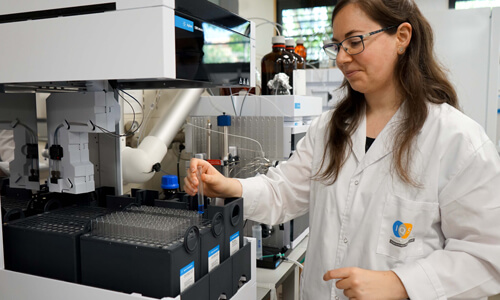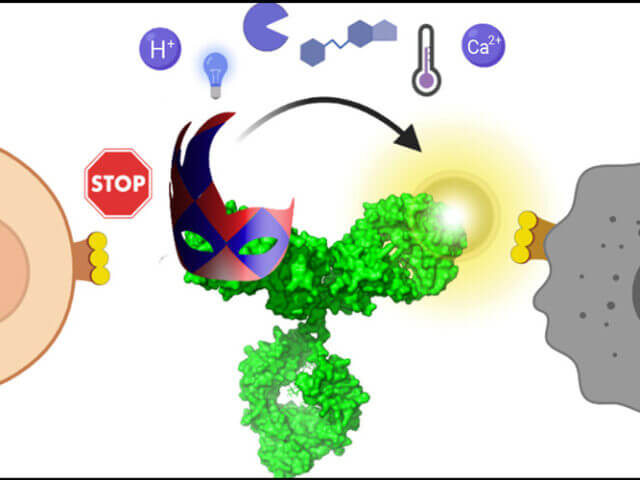Producing masked antibodies through targeted evolution

The Therapeutic Protein Laboratory led by Dr Benjamí Oller Salvia (with the GEMAT Materials Engineering Group at IQS School of Engineering) is developing strategies based on targeted antibody therapies to treat glioblastoma multiforme, the brain tumour with the worst prognostic.
Antibody-drug conjugates have shown great efficiency in treating various types of cancer. The drugs used in these therapies are too potent to be administered alone. However, binding (conjugation) to an antibody that directs them to target cells makes them a highly effective and selective therapy. Unfortunately, cancer cells do not always express the receptors that differentiate them rather well from healthy cells. For this reason, making these antibody conjugates activate only in the tumour can be critical to increasing their selectivity.
The new ADC2GBM project is framed within this context, and aims to develop antibody-drug biotherapies that have the ability to overcome the blood-brain barrier and be specifically activated in the brain tumour, producing new masked antibodies through targeted evolution. Leading this research is Dr Cristina Díaz Perlas, a postdoctoral researcher and specialist in targeted evolution through phage display. In addition, Dr Díaz has earned a prestigious European Marie Sklodowska-Curie grant to conduct her research.
We have had the pleasure to discuss all this with Dr Díaz and Dr Oller.
Cristina, how did you end up at IQS for your postdoc?
Díaz. I already knew Benjamí because we both did our doctorates at the IRB in Barcelona within Dr Ernest Giralt’s group, working in the research line of peptide launchers to release drugs in the brain. Afterwards, I did a three-year postdoc in Switzerland, at the École Polytechnique Fédérale de Lausanne, where we used the phage display technique to develop new peptides that could be used as drugs. In Lausanne, I also collaborated with a diagnostic testing company to look for peptides that are suitable for use in these tests.
When I was finishing my postdoc in Switzerland, Benjamí contacted me and offered me the possibility to apply to the ADC2GBM project together due to the similarity of our research interests. With my experience in the technique of creating peptide libraries for phage display and his experience in antibody engineering, we saw an opportunity for collaboration. I now want to continue my academic research at IQS, with a focus on applied research and greater agility to bring the solutions we find to society.
What does this new ADC2GBM project consist of?
Díaz. The acronym stands for Antibody Drug Conjugate to GlioBlastoma Multiforme. As its name suggests, we aim to create antibodies that target tumours located in the brain, which presents two fundamental difficulties. The first is that they must cross the blood-brain barrier, and one way to do this is by using peptide launchers. The second challenge involves efficiently removing tumour cells without affecting healthy cells. To do this, we must develop a very selective therapy.
What we want to do is create an antibody that has both functions: one that selectively attacks cancer cells in the brain and that is able to arrive in sufficient quantities by crossing the blood-brain barrier.
Oller. This project goes in line with other projects we’re conducting in the laboratory to develop activatable antibodies. However, what makes this project unique is that we’re aiming to use targeted evolution, an area in which Cristina is an expert, to produce the masks necessary for the antibodies by following a specific strategy to make antibody-drug conjugates.
“We’ll create libraries of masked antibodies and subject them to a targeted evolution process using the phage display technique”
Díaz. In the ADC2GBM project, we’ll create libraries of masked antibodies and subject them to a targeted evolution process using the phage display technique. It involves producing libraries of billions of bacteriophage viruses – which only infect bacteria – where each virus shows an antibody on its surface and also contains the genetic material that encodes this antibody as if it were a barcode. Why is this important? Because we can put billions of antibodies in contact with a certain antigen and use PCR amplification to find out which ones are attached.
Cristina, you’ve earned a grant from Marie Sklodowska-Curie Actions programme, which is awarded to develop talent and support advanced research. What has earning this grant meant to you?
Díaz. It’s an extremely prestigious and competitive grant from the European Commission, which values both people and projects. I’m convinced that the research we do is relevant, but I didn’t expect to receive it! It’s a great opportunity for me as well as fantastic recognition for the project, my personal growth, and the group’s trajectory. Also, I’m really happy because it has given me the opportunity to come back to Barcelona.
Oller.The MSCA highly values both the narrative of a good conjunction between researcher and project as well as the opportunity that the postdoctoral project represents for the researcher and what it can contribute to the host institution.
From your perspective as the coordinator of this research, Benjamí, what does the addition of Cristina mean for your group?
Oller. It’s a pleasure, and we’re really fortunate that Cristina has decided to come here with us, for various reasons. First, because we’ve known each other since our doctoral studies at the IRB, so it was easy to predict that she would be a good fit for the team. In addition, Cristina has our laboratory’s spirit of translational biological chemistry deeply ingrained. Regarding the research line on masked antibodies, her experience in targeted evolution and selection will be essential to establish new methodologies for developing masks. Her experience in peptide and protein development will be key in this project and others we’re doing within the group.
In terms of the research group, what does the addition of a postdoc contribute when the group is essentially composed of doctoral students and professors?
Oller. A postdoc researcher is a luxury! And an essential figure for developing cutting-edge research. A postdoc is an experienced person who is fully dedicated to research and who contributes a great deal to the group, both in terms of knowledge and as a mentor for students. Cristina’s experience in advanced techniques, some of which the group isn’t particularly strong with, is enabling us to make a qualitative leap forward in our research. In addition, she can share these new tools with students in the laboratory and contribute to their supervision. Cristina is also a senior postdoc, someone I can talk with “at the same level” when interpreting results or making decisions. Without a doubt, having a postdoc like her is a pleasure and a turning point for our group!
This project is funded by the European Commission.
RELATED PEOPLE:
RESEARCH GROUP
Materials Engineering
Chemical & Synthetic Biology for Biotherapies
RELATED PROJECTS
ADC2GBM (Development of brain-permeable masked nanobody-drug conjugates to eliminate glioma stem cells)





